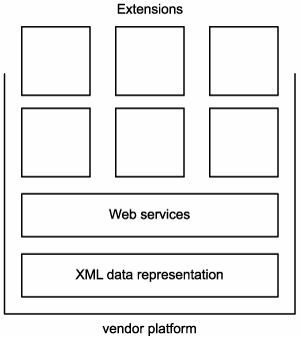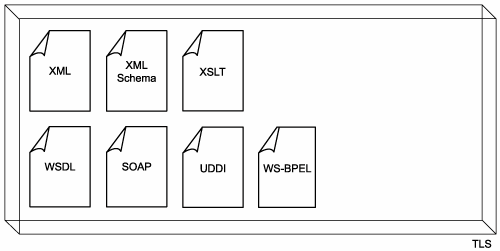Considerations for choosing SOA extensions
Although by completing Steps 1 and 2, we may have assembled a basic service-oriented environment consisting of core standards and planned service layers, Step 3 is where we get to compose unique variations of SOA (Figure 14.7).
Figure 14.7. WS-* extensions allow for individual SOAs to be uniquely composed.

14.4.1. Choosing SOA characteristics
As we've already established numerous times, primitive SOA is based on the principles of service-orientation that drive at the root of the service-oriented environment we are building. However, when you begin to explore how service-oriented business processes and application environments can be extended, composed, and even reconfigured, the true power of SOA really comes to light.
In Chapter 3 we established a list of contemporary SOA characteristics. We later revisited this list in Chapter 9 to determine which of these characteristics are provided by the primary influences that shape SOA, which we identified as:
- principles of service-orientation
- first-generation Web services concepts
- WS-* concepts
In the previous section of this chapter we covered the core standards that implement some service-orientation principles through first-generation Web services (and XML) specifications. Although there is some leeway as to what standards can be chosen (UDDI, for example, is not yet that common), for the most part, the first-generation Web services standards establish a commonly accepted core architecture and therefore are considered required components of contemporary SOA.
Most of the contemporary SOA characteristics we studied in Chapter 9 are optional, which means that we only need to pursue features of the characteristics we actually require. This is in line with the composite nature of SOA. As a result, the decisions we make regarding how we define our target SOA will be influenced heavily by how our requirements can be addressed or fulfilled by specific qualities of the architecture we are building.
Therefore, it is recommended that you identify the primary SOA characteristics you want your services to inherently support and promote. If you are building an application-level SOA that is destined to reside within an existing enterprise-wide SOA, then many of the required characteristics will have already been defined for you. However, if you are delivering your first service-oriented architecture, this becomes a critical decision point and one worth mulling over before proceeding with the design of service interfaces.
14.4.2. Choosing WS-* specifications
It is through the use of the many available WS-* specifications that we can build upon our foundation architecture extensions that implement features specific to our automation requirements. When you understand what characteristics or features you need your service-oriented architecture to support, you can begin exploring the possibility of those characteristics being realized through the use of the extensions provided by WS-* specifications.
Unfortunately, choosing which WS-* features we want as part of our service-oriented environment is not a matter of selecting a series of checkboxes on a form and clicking the "Apply" button. While the WS-* landscape continues to evolve, vendor support for some specifications will continue to remain inconsistent. Further, until a specification is fully implemented via a vendor platform, it is not uncommon for revisions to surface. Though parts of the WS-* arena remain volatile, other parts have become more settled.
Therefore, the key considerations for adding the features of a WS-* specification to your SOA is the maturity of the specification itself, and the available support it is receiving by product vendorsspecifically, vendors whose products you already are using.
14.4.3. WS-BPEL and SOA
Worth singling out at this point is the WS-BPEL specification. It is a good example of a WS-* extension for which relatively strong vendor support already exists. We first introduced concepts derived from WS-BPEL in Chapter 6 during our discussion of orchestration.
An operational business process language, such as WS-BPEL, is of immediate importance to our service design process because it enables us to create process services that establish the orchestration service layer (Figure 14.8).
Figure 14.8. WS-BPEL realizing the orchestration service sub-layer within our service layer.

A key advantage to working with WS-BPEL is that we are able to use its markup to create a process description with no ties to a particular implementation technology. Another reason we highlight WS-BPEL is because we use its syntax as part of the examples provided in Chapter 16, to demonstrate the creation of an orchestration layer for one of our case studies.
|
SUMMARY OF KEY POINTS |
|---|
|
Introduction
- Why this book is important
- Objectives of this book
- Who this book is for
- What this book does not cover
- How this book is organized
- Additional information
Case Studies
- Case Studies
- How case studies are used
- Case #1 background: RailCo Ltd.
- Case #2 background: Transit Line Systems Inc.
Part I: SOA and Web Services Fundamentals
Introducing SOA
- Introducing SOA
- Fundamental SOA
- Common characteristics of contemporary SOA
- Common misperceptions about SOA
- Common tangible benefits of SOA
- Common pitfalls of adopting SOA
The Evolution of SOA
- The Evolution of SOA
- An SOA timeline (from XML to Web services to SOA)
- The continuing evolution of SOA (standards organizations and contributing vendors)
- The roots of SOA (comparing SOA to past architectures)
Web Services and Primitive SOA
- Web Services and Primitive SOA
- The Web services framework
- Services (as Web services)
- Service descriptions (with WSDL)
- Messaging (with SOAP)
Part II: SOA and WS-* Extensions
Web Services and Contemporary SOA (Part I: Activity Management and Composition)
- Web Services and Contemporary SOA (Part I: Activity Management and Composition)
- Message exchange patterns
- Service activity
- Coordination
- Atomic transactions
- Business activities
- Orchestration
- Choreography
Web Services and Contemporary SOA (Part II: Advanced Messaging, Metadata, and Security)
- Web Services and Contemporary SOA (Part II: Advanced Messaging, Metadata, and Security)
- Addressing
- Reliable messaging
- Correlation
- Policies
- Metadata exchange
- Security
- Notification and eventing
Part III: SOA and Service-Orientation
Principles of Service-Orientation
- Principles of Service-Orientation
- Service-orientation and the enterprise
- Anatomy of a service-oriented architecture
- Common principles of service-orientation
- How service-orientation principles inter-relate
- Service-orientation and object-orientation (Part II)
- Native Web service support for service-orientation principles
Service Layers
- Service Layers
- Service-orientation and contemporary SOA
- Service layer abstraction
- Application service layer
- Business service layer
- Orchestration service layer
- Agnostic services
- Service layer configuration scenarios
Part IV: Building SOA (Planning and Analysis)
SOA Delivery Strategies
- SOA Delivery Strategies
- SOA delivery lifecycle phases
- The top-down strategy
- The bottom-up strategy
- The agile strategy
Service-Oriented Analysis (Part I: Introduction)
- Service-Oriented Analysis (Part I: Introduction)
- Service-oriented architecture vs. Service-oriented environment
- Introduction to service-oriented analysis
- Benefits of a business-centric SOA
- Deriving business services
Service-Oriented Analysis (Part II: Service Modeling)
- Service-Oriented Analysis (Part II: Service Modeling)
- Service modeling (a step-by-step process)
- Service modeling guidelines
- Classifying service model logic
- Contrasting service modeling approaches (an example)
Part V: Building SOA (Technology and Design)
Service-Oriented Design (Part I: Introduction)
- Service-Oriented Design (Part I: Introduction)
- Introduction to service-oriented design
- WSDL-related XML Schema language basics
- WSDL language basics
- SOAP language basics
- Service interface design tools
Service-Oriented Design (Part II: SOA Composition Guidelines)
- Service-Oriented Design (Part II: SOA Composition Guidelines)
- Steps to composing SOA
- Considerations for choosing service layers
- Considerations for positioning core SOA standards
- Considerations for choosing SOA extensions
Service-Oriented Design (Part III: Service Design)
- Service-Oriented Design (Part III: Service Design)
- Service design overview
- Entity-centric business service design (a step-by-step process)
- Application service design (a step-by-step process)
- Task-centric business service design (a step-by-step process)
- Service design guidelines
Service-Oriented Design (Part IV: Business Process Design)
- Service-Oriented Design (Part IV: Business Process Design)
- WS-BPEL language basics
- WS-Coordination overview
- Service-oriented business process design (a step-by-step process)
Fundamental WS-* Extensions
- Fundamental WS-* Extensions
- You mustUnderstand this
- WS-Addressing language basics
- WS-ReliableMessaging language basics
- WS-Policy language basics
- WS-MetadataExchange language basics
- WS-Security language basics
SOA Platforms
Appendix A. Case Studies: Conclusion
EAN: 2147483647
Pages: 150

